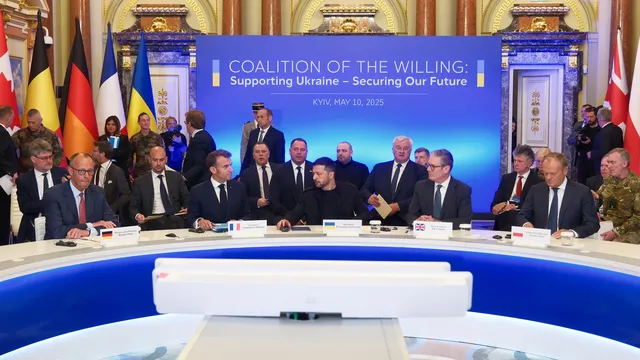
Ukraine and allies demand 30-day ceasefire to halt war with Russia
2025-05-11 13:47- European leaders gathered in Kyiv to discuss a proposed 30-day unconditional ceasefire between Ukraine and Russia, emphasizing the need for diplomacy.
- U.S. President Donald Trump has reiterated support for the ceasefire, while leaders warned of imposing sanctions on Russia if it does not agree.
- The coalition aims to strengthen security measures for Ukraine and curb further Russian aggression as the conflict continues.
Express your sentiment!
Insights
On May 10, 2025, leaders from France, the United Kingdom, Germany, and Poland convened in Kyiv to discuss a ceasefire strategy in Ukraine amid ongoing conflict with Russia. During this meeting, Ukrainian President Volodymyr Zelensky emphasized the need for a 30-day unconditional ceasefire to allow for diplomatic negotiations. The leaders expressed solidarity with Ukraine, indicating their support for a ceasefire initially proposed by U.S. President Donald Trump, and warned Russia of potential sanctions if it failed to comply. This initiative reflects rising concerns over the lasting effects of the war that began over three years ago. As the leaders from these European nations gathered, it marked both a symbolic and strategic move to counter Russia’s aggression. European Commission President Ursula von der Leyen outlined that the coalition would impose significant sanctions should Russia violate the proposed ceasefire. Trump has reiterated his backing of a ceasefire, stressing the urgency for peace discussions to develop from this pause in hostilities. The coalition seeks to leverage military support and sanctions to deter Russia from continuing its assault on Ukraine. Recent reports showcase ongoing violence in Ukraine. Despite Russia's claims of a temporary ceasefire, Ukrainian officials reported numerous attacks resulting in civilian casualties and destruction of residential properties. As the coalition’s proposal aims to create a space for peaceful dialogue, reports of renewed Russian offensives exacerbate concerns that a prolonged ceasefire may not be viable as tensions continue to escalate. The leaders hope to capitalize on this moment to unify their approach against Russian territorial ambitions. As the war extends into another year, the stakes for the region's political landscape become increasingly precarious. This ceasefire proposal is not merely a military strategy but a pronounced effort to reshape diplomatic interactions in Europe. The potential deployment of foreign troops, along with a commitment to bolster Ukraine's defense capabilities with enhanced military supplies, indicates a deeper commitment to Ukrainian sovereignty. The historical significance of these events is mirrored in the broader context of European defense policy and the future of NATO’s involvement in Eastern Europe, as Kyiv continues to pursue security guarantees amid its ongoing conflict with Russia.
Contexts
The conflict in Ukraine has its roots in a complex historical backdrop, marked by political, ethnic, and economic factors that began to coalesce after the dissolution of the Soviet Union in 1991. Ukraine declared independence on August 24, 1991, following a failed coup in Moscow, which catalyzed a surge of nationalist sentiment. However, internal divisions emerged, particularly between the predominantly Russian-speaking East and the Ukrainian-speaking West. These divides were exacerbated by a Soviet legacy and differing orientations towards Europe and Russia. Despite its independence, Ukraine struggled to orient itself in a geopolitical landscape dominated by the West and a resurgent Russia, which viewed Ukraine as part of its sphere of influence. The situation escalated dramatically in 2013 when then-President Viktor Yanukovych rejected a long-anticipated association agreement with the European Union, opting for closer ties with Russia instead. This decision sparked massive protests, known as the Euromaidan movement, reflecting a broad desire among Ukrainians, especially in the West, for democratic reforms and European integration. In February 2014, these protests culminated in Yanukovych's ousting, triggering a severe crisis. Russia responded by annexing Crimea in March 2014, asserting historical claims and strategic interests in the region. This annexation was widely condemned by the international community and was viewed as a violation of international law, leading to the imposition of sanctions on Russia. Following the annexation, pro-Russian separatists declared independence in the Donetsk and Luhansk regions of Eastern Ukraine, sparking a protracted and bloody conflict. The Ukrainian government labeled these groups as terrorists, while Russia provided covert support, leading to a prolonged struggle that has claimed thousands of lives and displaced many more. International attempts to broker a solution, most notably the Minsk agreements, have faced multiple challenges, with violations on both sides and a lack of trust undermining efforts. The conflict morphed into a low-intensity war characterized by trench warfare, propaganda, and intermittent ceasefires. As of May 2025, the situation remains unresolved, with ongoing tensions between Ukraine and Russia impacting regional and global politics. Ukraine continues to seek integration with Western institutions such as NATO and the EU, despite Russia's opposition. The humanitarian toll is significant, with millions affected by displacement and economic instability. The conflict has also highlighted issues of national identity, sovereignty, and the international order, prompting discussions about security in Eastern Europe and the West's responses to aggression. The conflict in Ukraine serves as a poignant reminder of the fragility of statehood and the enduring impact of historical grievances woven into the fabric of national and international relations.